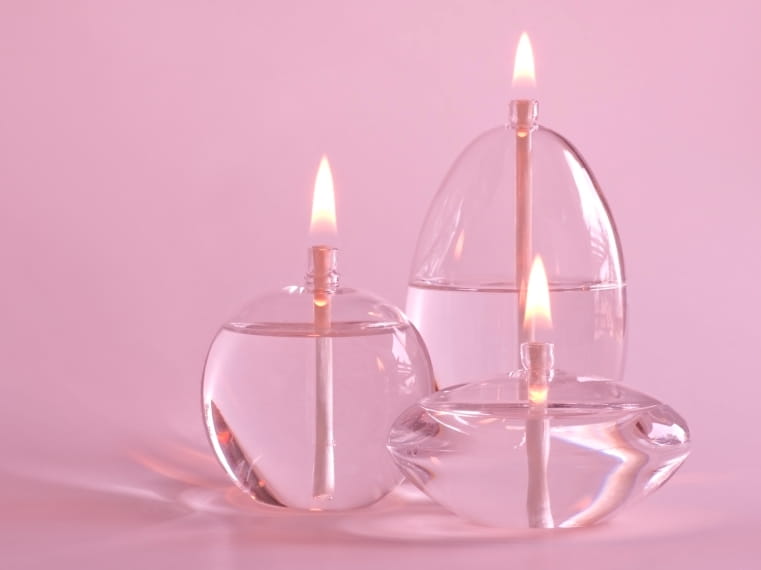My Child Swallowed Lamp Oil A Guide to Address Unintentional Poisoning

The Bottom Line
Lamp oil can provide warm, glowing light. If swallowed, however, lamp oil can cause serious injury that might not be apparent right away.

The Full Story
Oil lamps are used as decorations, part of religious observances, or sometimes as necessities if the power goes out. To a child, colored lamp oil looks like a beverage; clear lamp oil looks like water. Adults can be easily fooled, too. Most lamp oil is made of paraffin. If paraffin lamp oil is swallowed, it is poorly absorbed from the gastrointestinal tract. However, it can easily be aspirated (slide down into the lungs). This can cause severe breathing difficulties and pneumonia. These symptoms might not happen right away. Some scented lamp oils used in special fragrance lamps, contain alcohols.
Lamp oil should be kept in its original container until you pour it into the lamp. Store it up high, locked and out of sight and reach of children. Once the lamp is lit, be sure that it is out of the reach of children and pets and on a safe and level surface where it can’t tip over and cause a fire.
If you think someone might have swallowed lamp oil, call Poison Control right away at 1-800-222-1222 or use the webPOISONCONTROL® tool for online guidance. The ingredients can vary considerably between products. If possible, have the original container at hand when you call to help with correct identification. Coughing is a clue that the lamp oil might have gone into the lungs. In that case, Poison Control might recommend a chest x-ray to determine if there is a problem. Even if there are no symptoms, Poison Control will keep in touch with you for a day or so to be sure that problems don’t develop.
William G. Troutman, PharmD
Clinical Toxicologist & Professor of Pharmacy emeritus
Mary Elizabeth May, RN, BA, MPH
Certified Specialist in Poison Information
Poisoned?
Call 1-800-222-1222 or
Prevention Tips
- Store lamp oil in its original container.
- Store lamp oil where children can’t reach it.
- Oil lamps can cause fires. Never leave them burning when there are no adults present to ensure safety.
This Really Happened
A 3-year-old girl drank lamp oil and was coughing. Her parents called 911 and were connected to Poison Control for guidance. The poison specialist recommended emergency room (ER) evaluation due to potential lung injury from aspiration of the oil (sliding down into the lungs). The child was taken to the ER where she was drowsy, breathing fast and had a fever. Her initial chest x-ray was normal. Poison Control recommended a repeat chest x-ray 6 hours after she drank the lamp oil since x-ray evidence of aspiration pneumonitis (inflammation of the lungs) may be delayed for several hours.
The repeat chest x-ray showed pneumonitis. The child was admitted to the hospital 15 hours after the ingestion. She was still breathing fast and had a low-grade fever but was not in distress. Twenty-four hours after the child swallowed the lamp oil, her coughing and fever had resolved. Her breathing rate was still elevated, but her lungs sounded clear and she was not in any distress. A repeat chest x-ray however showed mild infiltrates (densities in the lungs that normally shouldn’t be present) on both sides. She was observed in the hospital one more day and then sent home in good condition.
References
Poisoned?
Call 1-800-222-1222 or
Prevention Tips
- Store lamp oil in its original container.
- Store lamp oil where children can’t reach it.
- Oil lamps can cause fires. Never leave them burning when there are no adults present to ensure safety.
This Really Happened
A 3-year-old girl drank lamp oil and was coughing. Her parents called 911 and were connected to Poison Control for guidance. The poison specialist recommended emergency room (ER) evaluation due to potential lung injury from aspiration of the oil (sliding down into the lungs). The child was taken to the ER where she was drowsy, breathing fast and had a fever. Her initial chest x-ray was normal. Poison Control recommended a repeat chest x-ray 6 hours after she drank the lamp oil since x-ray evidence of aspiration pneumonitis (inflammation of the lungs) may be delayed for several hours.
The repeat chest x-ray showed pneumonitis. The child was admitted to the hospital 15 hours after the ingestion. She was still breathing fast and had a low-grade fever but was not in distress. Twenty-four hours after the child swallowed the lamp oil, her coughing and fever had resolved. Her breathing rate was still elevated, but her lungs sounded clear and she was not in any distress. A repeat chest x-ray however showed mild infiltrates (densities in the lungs that normally shouldn’t be present) on both sides. She was observed in the hospital one more day and then sent home in good condition.
